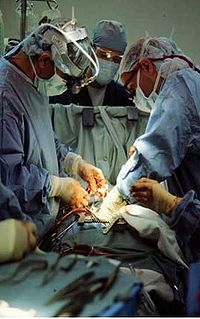
Photo from wikipedia
Introduction Trainees underestimate the amount of operative autonomy they receive, whereas faculty overestimate; this has not been studied in robotics. We aimed to assess the perceptions and expectations of our… Click to show full abstract
Introduction Trainees underestimate the amount of operative autonomy they receive, whereas faculty overestimate; this has not been studied in robotics. We aimed to assess the perceptions and expectations of our general surgery trainees and faculty on robotic console participation in academic surgery. Methods A survey was administered to general surgery robotic faculty and trainees eligible to sit at the console. Participants estimated the average percentage of trainee console participation time (CPT) per case for robotic cholecystectomies (CCY) and inguinal hernia repairs (IHR) from January to June 2019. Trainees were additionally asked what CPT they expected according to their training level (novice or senior). Expected CPTs were compared to actual CPTs extracted from robotic console logs during the same time frame. Results Survey response rate was 80% for faculty (4 of 5) and 65% for trainees (15 of 23). Novices expected a higher CPT than they perceived in CCY (42.8% ± 14.8% vs 19.0% ± 17.2%, p = 0.03) and IHR (36.1% ± 17.6% vs. 10.7% ± 13.7%, p = 0.01), but in actuality, they did more CPT than perceived (by 34.9% in CCY, p < 0.01; 14% in IHR, p = 0.10). Senior trainees accurately perceived their CPT in IHR, but expected a higher CPT by 15.9% ( p = 0.04). In CCY, seniors perceived a 23.8% higher CPT than in reality ( p = 0.04). Faculty generally overperceived trainee CPT by 12.8–16.3% ( p > 0.05). Compared to faculty, novices perceived lower CPTs in both CCY by 29.9% ( p = 0.16) and IHR by 26.8% ( p = 0.07), but seniors tended to agree with the faculty-perceived CPTs ( p > 0.05). Conclusion Our robotic trainees expect to do more on the console than they perceive. Faculty think they allow their trainees more participation than in reality. Compared to faculty perception, novice trainees perceive a much lower level of trainee participation than senior trainees do. Expectation setting and standardizing learning curves are important for robotic surgery training.
Journal Title: Surgical Endoscopy
Year Published: 2020
Link to full text (if available)
Share on Social Media: Sign Up to like & get
recommendations!